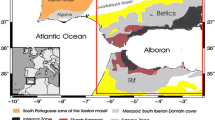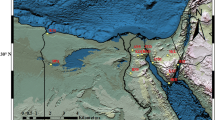Abstract
In this study, receiver functions from ten Broadband seismograph stations on Cenozoic sediment formations of Brahmaputra valley and its neighboring region in northeastern part of India are determined. Receiver function traces from this region show delay in peak by 1–2.5 s and associated minor peaks with the direct P-phase peak. Based on such observation, we try to image sedimentary structure of the Brahmaputra valley plain, adjacent Shillong plateau and Himalayan foredeep region. An adapted hybrid global waveform inversion technique has been applied to extract sedimentary basin structure beneath each site. The sedimentary cover of the basin is about 0.5–6.5 km thick across the valley, 0.5–1.0 km on Shillong plateau and 2.0–5.0 km in nearby foredeep region. We have found that sedimentary thickness increases from SW to NE along the Brahmaputra valley and towards the Eastern Himalayan syntaxes. The estimated sediment thickness and S wave velocity structure agree well with the results of previous active source, gravity, and deep borehole studies carried out in this region. The thick crustal low velocity sediment cover in Brahmaputra valley is expected to amplify ground motions during earthquakes and therefore important for seismic hazard assessment of the region.









Similar content being viewed by others
References
Ambraseys, N., & Bilham, R. (2003). MSK isoseismal intensities evaluated for the 1897 Great Assam Earthquake. Bulletin of the Seismological Society of America, 93, 655–673.
Ammon, C. J. (1991). The isolation of receiver effects from the teleseismic P waveforms. Bulletin of Seismological Society of America, 81, 2504–2510.
Ammon, C. J., Randall, G. E., & Zandt, G. (1990). On the non-uniqueness of receiver function inversions. Journal of Geophysical Research, 95, 15303–15318.
Angelier, J., & Baruah, S. (2009). Seismotectonics in Northeast India: a stress analysis of focal mechanism solutions of earthquakes and its kinematics implications. Geophysical Journal International,. doi:10.1111/j.1365-246x.2009.04107.x.
Ball, J. S., Sheehan, A. F., Stachnik, J. C., Lin, F. C., & Collins, J. A. (2014). A joint Monte Carlo analysis of seafloor compliance, Rayleigh wave dispersion and receiver functions at ocean bottom seismic stations offshore New Zealand. Geochemistry, Geophysics, Geosystems, 15, 5051–5068. doi:10.1002/C005412.
Baruah, J. M. B., Mukhopadhyay, A., & Baishya, N. (1975). Lithospheric variation and paleostrustural evolution of Tipam Sandstone formation in part of Upper assam valley. Symp: Sed. Sedimentation & Sedimentary Env.
Bhattacharya, P. M., Mukhopadhyay, S., Majumdar, R. K., & Kayal, J. R. (2008). 3-D seismic structure of the northeast India and its implicationfor local and regional tectonics. Journal of Asian Earth Science, 33, 25–41.
Borcherdt, R. D. (1970). Effects of local geology on ground motion near San Francisco Bay. Bull. Seism. Soc. Am., 60(1), 29–61.
Borcherdt, R.D. & Glassmeyer, G. (1990). Local Geology and its Influence on strong Ground Motion Generated by the Lorna Prieta Earthquake of October 17, 1989”, proceedings, Putting the Pieces Together, Bay Area preparedness Project, October, San Francisco.
Cassidy, J. F. (1992). Numerical experiments in broadband receiver function analysis. Bulletin of the Seismological Society of America, 82(3), 1453–1474.
Chen, W. P., & Molnar, P. (1990). Source parameters of earthquakes and intraplate deformation beneath the Shillong Plateau and northern Indo-Burma ranges. Journal of Geophysical Research, 95, 12527–12552.
Chopra, S., Chang, T. M., Saikia, S., Yadav, R. B. S., Choudhury, P., & Roy, K. S. (2014). Crustal structure of the Gujarat region, India: new constraints from the analysis of teleseismic receiver functions. Journal of Asian Earth Sciences, 96, 237–254.
Christensen, N. I. (1996). Poisson’s ratio and crustal seismology. Journal of Geophysical Research, 101, 3139–3156.
Cramer, C. H. (2003). Site specific seismic hazard analysis that is completely probabilistic. Bulletin of the Seismological Society of America, 93(4), 1841–1846.
Das, K.C., Sarma, V.S.B., Ayyadurai, M. (2004), Gondwana Sediments: A Promising Hydrocarbon Exploration Target in Assam Shelf,5th Conference & Exposition on Petroleum Geophysics, Hyderabad, pp 468–472.
Evans, P. (1932). Tertatry succession in Assam. Trans. Min. Geol. Inst. India, 27, 155.
Gururajan, N. S., & Choudhury, B. K. (2003). Geology and tectonic history of the Lohit Valley, Eastern Arunachal Pradesh, India. Journal of Asian Earth Sciences, 21, 731–741.
Handique, G. K., & Dutta, S. K. (1980). A study of the Surma-Tipam groups of Assam valley, south of Brahmaputra, Geo. Survey of India, 25, 42–52.
Hazarika, D., Arora, B. R., & Bora, C. (2011). Crustal structure and deformation in the northeast India-Asia collision zone: constraints from Receiver function analysis. Geophysical Journal International,. doi:10.1111/j.1365-246X.2011.05267.x.
He, C., Dong, S., Santosh, M., & Chen, X. (2013). Seismic evidence for a geosuture between the Yangtze and Cathaysia Blocks. South China. Sci. Rep., 3, 2200. doi:10.1038/srep02200.
Hetenyi, G., Cattin, R., Jerome, V., & Nabelek, J. L. (2006). The effective elastic thickness of the India Plate from receiver function imaging, gravity anomalies and thermomechanical modelling. Geophysical Journal International, 167, 1106–1118.
Kayal, J. R., Arefiev, S. S., Baruah, S., Hazarika, D., Gogoi, N., Kumar, A., et al. (2006). Shillong Plateau earthquakes in northeast India region: complex tectonic model. Current Science, 91(1), 109–114.
Kayal, J. R., & De, R. (1991). Microseismicity and tectonic in Northeast India. Bulletin of Seismological Society America, 81, 131–138.
Kind, R., Kosarev, G., & Petersen, N. (1995). Receiver function at the stations of the German Regional Seismic Network (GRSN). Geophysical Journal International, 121, 191–202.
Kumar, T.S., Bharali, B.R., Verma, A.K. (2012). Basement configuration and structural style in OIL’s operational areas of Upper Assam, AAPG, 50739.
Lahiri, S. K., & Sinha, R. (2014). Morphotectonic evolution of the Majuli Island in the Brahmaputra valley of Assam, India inferred from geomorphic and geophysical analysis. Geomorphology, 227, 101–111.
Langston, C. A. (1979). Structure under Mount Rainer, Washington, inferred from teleseismic body waves. Journal Geophysical Research, 84, 4749–4762.
Langston, C. A. (2011). Wave-field continuation and decomposition for passive seismic imaging under deep unconsolidated sediments. Bulletin of the Seismological Society of America, 101(5), 2176–2190.
Li, J., Tian, B., Wang, W., Zhao, L., & Yao, Z. (2007). Short Note Lateral Variation in the Sedimentary Structure of West Bohai Bay Basin Inferred from P-Multiple Receiver Functions. Bulletin of the Seismological Society of America, 97, 1355–1363.
Ligorria, J. P., & Ammon, C. J. (1999). Iterative Deconvolution and Receiver-Function estimation. Bulletin of the Seismological Society of America, 89, 1395–1400.
Mallet, F. R. (1876). On the coal field of Naga hills, bordering the Sibsagar and Lakhimpur districts. Geological Survey of India Memoirs, 12, 1–95.
Mathur, L.P. & Evans, P. (1964), Oil in India (Sp.Brochure), 22nd Int. Geol. Congress, New Delhi, p. 85.
Mavko, G. M. (1980). Velocity and attenuation in partially molten rocks. Geophysical Journal International, 85, 5173–5189.
Meijde, M. V. D., Van der Lee, S., & Giardini, D. (2003). Crustal structure beneath broad-band seismic stations in the Mediterranean region. Geophysical Journal International, 152, 729–739.
Murthy, K. N. (1983). Geology and hydrocarbon prospects of Assam Shelf-recent advances and present status. Petrol. Asia Jour., 6(2), 1–14.
Nandy, D.R. (1976). The Assam syntaxis of the Himalayas—a re-evaluation. Geological Survey of India Misc. Pub., 24(2), 363–367.
O’Connell, R. J., & Budiansky, B. (1974). Seismic velocities in dry and saturated cracks solids. Journal of Geophysical Research, 79, 5412–5426.
Oldham, R. D. (1899). Report on the great earthquake of 1897. Calcutta: Geological Survey of India.
Owens, T. J., Zandt, G., & Taylor, S. R. (1984). Seismic evidence for an ancient rift beneath the Cumberland Plateau, Tennessee. Journal of Geophysical Research, 116, 618–636.
Pickett, G. R. (1963). Acoustic character logs and their applications in formation evaluation. Journal of Petroleum Technology, 15, 650–667.
Rao, N. P., & Kumar, M. R. (1997). Uplift and tectonics of the Shillong plateau, Northeast India. Journal of Physics and Earth, 45, 167–176.
Report on “Geology and Mineral resources of Assam”, (2009) Geological Survey of India, 30, vol. 4.
Sambridge, M. (1999a). Geophysical inversion with a neighborhood algorithm-I. search a parameter space. Geophysical Journal International, 138, 479–494.
Sambridge, M. (1999b). Geophysical inversion with a neighbourhood algorithm-II. Appraising the ensemble. Geophysical Journal International, 138, 727–746.
Sandvol, E., Seeber, D., Calvert, A., and Barazangi, M. (1998), Grid search modelling of receiver functions: Implications for crustal structure in the Middle East and North Africa, J. geophys. Res., 103, 26 899–26 917.
Seeber, L., Armbruster, J. G., & Quimeyer, R. (1981). Seismicity and continental subduction in the Himalayan Arc. In H. K. Gupta & F. M. Delany (Eds.), Zagros, Hindu Kush, Himalaya, Geodynamic Evolution, Geodynamic Series (Vol. 3, pp. 215–242). Washington, DC: America Geophysical Union.
Sheehan, A.F., Abers, G.A., Jones, C.H., Lerner-Lam, L. (1995), Crustal thickness variations across the Colorado Rocky Mountains from teleseismic receiver functions, J. Geophys. Res., B10, 100, 20,391–20404.
Shibutani, T., Sambridge, M., & Kennett, B. L. N. (1996). Genetic algorithm inversion for receiver functions with application to crust and uppermost mantle structure beneath eastern Australia. Geophysical Research Letters, 23, 1829–1832.
Shrivastava, P. K., Ganesan, S., & Roy, D. (1974). Tipam Group in the sub surface of Assam Valley, south of Brahmaputra. Geological Society of India, 15(2), 165–181.
Srinivas, D., Srinagesh, D., Chadha, R. K., & Kumar, M. R. (2011). Sedimentary thickness variations in the Indo-GangeticForedeep from inversion of receiver functions. Bulletin of the Seismological Society of America, 103, 2257–2265.
Tandon, A. N. (1954). A study of Assam earthquake of August 1950 and its aftershocks. Indian J. Meteorol. Geophys., 5, 95–137.
Zandt, G., & Ammon, C. J. (1995). Continental crust composition constrained by measurements of crustal Poisson’s ratio. Nature, 374, 152–154.
Zhao, L. S., Sen, M. K., Stoffa, P., & Frohlich, C. (1996). Application of very fast simulated annealing to the determination of the crustal structure beneath Tibet. Geophysical Journal International, 125(2), 355–370.
Zheng, T. Y., Zhao, L., & Chen, L. (2005). A detailed receiver function image of the sedimentary structure in the Bohai Bay Basin. Physics of the Earth and Planetary Interiors, 152, 129–143.
Acknowledgments
We are thankful to the technical persons of India Meteorological Department for helping to get the earthquake data. SS greatly acknowledged Atul Kumar and Sunil Rohilla for fruitful discussion. I am also indebted to Prof. L. Zhu and two unanimous reviewers, who suggested numerous improvements to the manuscript. The GMT software package distributed by Wessel and Smith (1995) was used for mapping the figures.
Author information
Authors and Affiliations
Corresponding author
Rights and permissions
About this article
Cite this article
Saikia, S., Chopra, S., Baruah, S. et al. Shallow Sedimentary Structure of the Brahmaputra Valley Constraint from Receiver Functions Analysis. Pure Appl. Geophys. 174, 229–247 (2017). https://doi.org/10.1007/s00024-016-1371-3
Received:
Revised:
Accepted:
Published:
Issue Date:
DOI: https://doi.org/10.1007/s00024-016-1371-3




